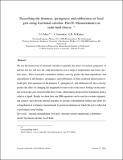| dc.contributor.author | Faber, T.J. | |
| dc.contributor.author | Jaishankar, Aditya | |
| dc.contributor.author | McKinley, Gareth H | |
| dc.date.accessioned | 2018-01-16T20:21:37Z | |
| dc.date.available | 2018-01-16T20:21:37Z | |
| dc.date.issued | 2016-07 | |
| dc.date.submitted | 2016-06 | |
| dc.identifier.issn | 0268-005X | |
| dc.identifier.uri | http://hdl.handle.net/1721.1/113213 | |
| dc.description.abstract | We use the framework of fractional calculus to quantify the linear viscoelastic properties of full-fat, low-fat, and zero-fat, semi-hard cheeses over a range of temperatures and water/protein ratios. These fractional constitutive models correctly predict the time-dependence and interrelation of the firmness, springiness, and rubberiness of these emulsion-filled hydrocolloidal gels. Our equations for the firmness F, springiness S, and rubberiness R, also correctly predict the effect of changing the magnitude or time-scale of the stress loading on the material even in the case of irreversible flow events, when cheese progressively transitions from a solid to a liquid. Finally we show how our FSR-equations can be used in a texture engineering context; they provide rational guidance to product reformulation studies and allow for extrapolation of a firmness measurement to practical situations in which the gel is subjected to prolonged creep loading. Keywords
Rational reformulation
Food gels
Structure-texture engineering
Constitutive model
Fractional calculus
Scott Blair | en_US |
| dc.publisher | Elsevier | en_US |
| dc.relation.isversionof | http://dx.doi.org/10.1016/J.FOODHYD.2016.06.038 | en_US |
| dc.rights | Creative Commons Attribution-NonCommercial-NoDerivs License | en_US |
| dc.rights.uri | http://creativecommons.org/licenses/by-nc-nd/4.0/ | en_US |
| dc.source | MIT Web Domain | en_US |
| dc.title | Describing the firmness, springiness and rubberiness of food gels using fractional calculus. Part II: Measurements on semi-hard cheese | en_US |
| dc.type | Article | en_US |
| dc.identifier.citation | Faber, T.J. et al. “Describing the Firmness, Springiness and Rubberiness of Food Gels Using Fractional Calculus. Part II: Measurements on Semi-Hard Cheese.” Food Hydrocolloids 62 (January 2017): 325–339 © 2016 Elsevier Ltd | en_US |
| dc.contributor.department | Massachusetts Institute of Technology. Department of Mechanical Engineering | en_US |
| dc.contributor.mitauthor | Jaishankar, Aditya | |
| dc.contributor.mitauthor | McKinley, Gareth H | |
| dc.relation.journal | Food Hydrocolloids | en_US |
| dc.eprint.version | Author's final manuscript | en_US |
| dc.type.uri | http://purl.org/eprint/type/JournalArticle | en_US |
| eprint.status | http://purl.org/eprint/status/PeerReviewed | en_US |
| dc.date.updated | 2018-01-16T18:53:56Z | |
| dspace.orderedauthors | Faber, T.J.; Jaishankar, A.; McKinley, G.H. | en_US |
| dspace.embargo.terms | N | en_US |
| dc.identifier.orcid | https://orcid.org/0000-0001-8323-2779 | |
| mit.license | PUBLISHER_CC | en_US |
